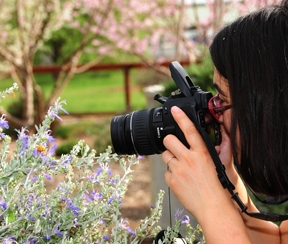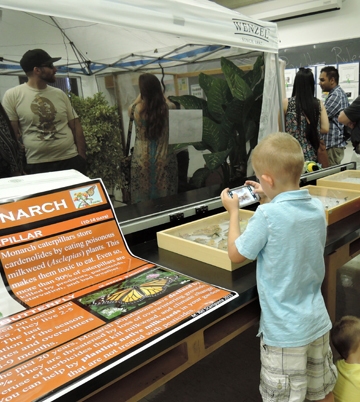- Author: Kathy Keatley Garvey

They go together like honey bees on bee balm and bumble bees on tomatoes.
When you attend the 102nd annual campuswide UC Davis Picnic Day on Saturday, April 16, be sure to head over to Briggs Hall, Kleiber Hall Drive, to see the Pollinator Pavilion, which will emphasize the importance of pollinators in both natural environments and food production.
"It is often said that one in every three bites of food we take is dependent on animal pollination," said Pavilion Pollinator coordinator Margaret "Rei" Scampavia, a doctoral candidate in entomology. "While there are some foods that do not rely on animal pollination, many of the tastiest and most nutritious food does. To this end, we have a series of posters demonstrating what a meal might look like with and without foods that benefit from animal pollination."

"We are going to have a series of exhibits showcasing pollinator diversity, demonstrating their importance in natural ecosystems and food production, and providing information on what members of the general public can do to help native pollinators," Scampavia said.
"We will have information on a wide variety of animal pollinators, including butterflies, flies, wasps, birds, and even bats. But the majority of the exhibit will focus on the most abundant pollinators: native bees."
The highlight is the walk-in Pollinator Pavillion, an enclosure where visitors can "safely view live pollinators, such as bees, butterflies and flies, up close and in person," the entomologist said. "Younger guests can practice scientific observation by filling out specially provided data sheets. Some of the species present will include: blue orchard bees, Monarch butterflies, Red Admiral butterflies, and Painted Lady butterflies."
Scampavia points out that the European honey bee "is the first thing many people think of when they hear the word pollinator. But in reality, this species is only one of tens of thousands of pollinator species; there are more than 20,000 species of bee besides the honeybee, for example. We hope that visitors to this exhibit will leave with a greater appreciation of the amazingly diverse animals that pollinate flowers."
Last year scores of enthusiastic visitors packed the Pollinator Pavilion. It proved to be one of the most popular, well-crafted, well-designed Picnic Day displays. Another eagerly anticipated event awaits Saturday.
And now there's an urgency.
"Many pollinator species are experiencing alarming declines," Scampavia said. "Monarch butterflies, for example, have declined by over 90 percent in the past ten years. To promote awareness of the plight of the Monarch, we have a series of exhibits with live caterpillars, chrysalises, and adults, which also contain important information about this species and what we can do to prevent further losses. There will also be information about ways to enhance outdoor spaces to promote and sustain healthy wild, native pollinators."




